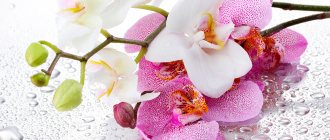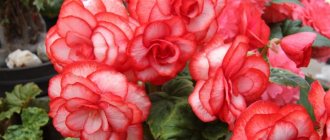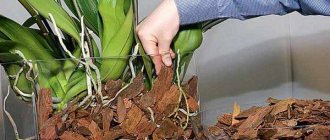The orchid has long become a regular on window sills and flower beds in Russian apartments.
However, caring for a tropical beauty is still surrounded by many myths. Dear readers!
For you, we have created communities on social networks in which useful articles and interesting ideas are published several times a day! Subscribe and receive useful content in a convenient format! In today’s article we will look at what products need to be used and what to water with so that the orchid blooms quickly and effectively at home.
What liquid fertilizers do orchids need?
When choosing fertilizers for an orchid so that it blooms quickly, you should give preference to liquid formulations. The fact is that nutrients in liquid form are better absorbed by the plant.
In addition, phalaenopsis growing at home does not tolerate fertilizers in any other form. Therefore, even if you bought drugs in a different form factor, they still need to be dissolved in water.
For orchids, it is allowed to use both specialized fertilizers and universal mixtures. But there is a rule. When using universal mixtures, their concentration is reduced by at least half.
IMPORTANT! Before applying fertilizer, soak the roots of the phalaenopsis in warm, settled water.
Step-by-step instructions: how to care at home?
Action steps
- Provide the plant with comfortable conditions.
- Monitor the condition of the soil: water and fertilize the flower in time.
- Properly care for leaves and roots.
Content
The health of an orchid directly depends on the conditions of its maintenance . For maximum growth and active flowering, several rules must be followed:
- The flower should not be left in direct sunlight. The light must be diffused.
- In spring and summer, during times of strong solar activity, it is best to stick a matte film on the window, which will protect the plant from burns.
- Lack of light negatively affects the health of the orchid, therefore, if there is a lack of natural light, you should resort to artificial lighting.
Watering
The orchid requires moderate watering : it does not tolerate stagnation of moisture in the roots. During flowering, the plant requires more intense moisture.
The frequency and amount of watering directly depends on the time of year:
- In winter , the plant does not require moisture, so it needs to be watered extremely rarely and very carefully.
- In summer, the orchid requires watering 2-3 times a week. This needs to be done correctly: fill a basin with boiled or settled water, put a flower pot in it and hold it in it for 15-20 minutes. Afterwards, let the moisture drain and return it to its place.
Top dressing
The plant should be fertilized when it is in the growth phase, no more than once every 20 days.
Attention! For orchids, only fertilizer that is intended for this species is suitable. Read the instructions carefully so as not to ruin the flower!
The plant's soil also requires care : it should be washed once a week to prevent an excess of mineral salts. If the gardener has the opportunity to change the soil annually, then fertilizers can be completely abandoned.
What folk remedies can you water an orchid to make it bloom?
In order to stimulate orchid flowering at home, it is not at all necessary to buy drugs in the store. It is quite possible to prepare effective fertilizers according to folk recipes.
Below are the most popular folk fertilizers that can be used to water an orchid.
Banana peel infusion
Banana peels are rich in potassium, an important element for an orchid to bloom quickly and efficiently.
The working solution is prepared at home as follows: pour one banana peel with a liter of water for 2 days. The resulting concentrate is diluted in a 1 to 1 ratio with clean water.
Water the flower with the working solution.
Potato decoction
The water left over from boiling potatoes contains potassium, phosphorus, and starch.
To enhance the effectiveness of the liquid, you can add a spoonful of sugar to it. Based on 1 tbsp. spoon for 2 liters of broth.
IMPORTANT! Before watering, the working solution must be cooled!
Onion broth
An infusion of onion peels is prepared as follows: pour a handful of onion peels into 3 liters of water. The mixture is boiled and allowed to brew for half a day.
The working solution is prepared in a ratio of 1 to 3.
Ash infusion
Ash is one of the best organic fertilizers that you can water your orchid at home.
The working solution is prepared as follows: 200 grams of ash are mixed with a liter of water and infused for 24 hours.
Before watering the orchid, the solution must be filtered through cheesecloth.
Congee
The water obtained after cooking rice is rich in beneficial substances that phalaenopsis needs. The main thing is to remember to cool the liquid so as not to damage the roots.
What ready-made liquid fertilizers for watering promote orchid flowering?
If you don’t want to bother with preparing nutritional mixtures yourself, you can purchase ready-made options.
Dr. Foley Orchid
This drug is used for foliar treatment of plants at home. Stimulates bud formation. Also, Dr. Foley Orchid is a very effective remedy for chlorosis.
Bona Forte
Stimulates the formation of flower stalks.
It has a balanced composition, most suitable for orchids. In addition to beneficial micronutrients, it contains vitamins necessary for immunity and improved photosynthesis.
Brexil Combi
Eliminates iron deficiency. Used for spraying. It is necessary to water regularly, once every three weeks.
Pokon for orchids
Complex composition suitable for year-round use. The working solution is prepared from 5 ml of the drug diluted in 1 liter of water.
Agrekol
Gel-like mixture of active ingredients. Diluted in water, then used for watering every 3-7 days.
Housing and communal services Flower paradise
Domestic preparation for root feeding. Standard for preparing a working solution: 10 ml per 1 liter of water.
Care after transplant
The most important thing after transplanting is to give enough light, but not direct sun .
After planting , water immediately or the next day, but not later.
If during the winter months you cannot provide light to the orchid after transplantation, then it is better not to buy it.
If transplanted correctly, the orchid should not notice this. There should be no wilting of leaves or dropping of flowers.
Reasons for leaf wilting after transplantation
1. Not enough moisture.
There may be a lack of moisture for two reasons:
- insufficient watering or the substrate does not take up water (fresh living bark);
- lack of roots (rotten, dried out).
2. If the orchid is placed in the sun after transplantation .
Yellowing of leaves
It is normal if the bottom leaf turns yellow at the end or evenly . A leaf that has turned yellow at the end must be removed, tearing it off completely when it has turned 2/3 yellow.
If the leaf turns yellow from the stem , then most likely the stem is rotting . If the leaf turns yellow from the stem, remove it immediately and look at what’s wrong with the stem. If it rots, then clean it and treat it with fungicides.
Causes of drying buds and flowers
The main reasons for the drying (withering) of flowers and buds:
1. Lack of light.
2. Lack of moisture and overdrying. If there is a lack of moisture, photosynthesis cannot proceed normally, the orchid cannot flower, and therefore drops its flowers.
3. Excessive sun exposure to the orchid and its flowers.
4. The orchid gets exposed to cold frosty air from the window when ventilating.
5. Pests.
What fertilizers activate the kidneys
As you know, flowers appear from buds. In order for an orchid to bloom luxuriously at home, it is necessary to lay the foundations for future flowering.
This is not a one-time process; different types of nutritional mixtures will have to be added in several stages.
Let's look at them all:
- Nitrogen-containing liquid compositions. Nitrogen should be used as a nutrient during the first watering after flowering. In this case, the feeding procedure is not carried out for the next 15-20 days.
- Potassium-phosphorus liquid preparations. Used several times during the period from the appearance of the first buds to the fall of the last petals.
- Special mixtures “for orchids”. For example, from the Forte company. Such complexes contain an optimal balance of micronutrients specially selected for orchids.
Fertilizer for the plant to bloom
In spring and autumn, fertilizers are applied twice a month , in summer and winter - once.
For one-time feeding:
- Sphagnum peat moss is an excellent, permanent fertilizer and, at the same time, drainage.
- Blank sheet in sticks . One or two sticks are enough for three months. Suitable for complete nutrition.
For permanent:
- Embiko Orchid . To be paid once every 10 days.
- Fertika-lux . For year-round use, as well as before flowering.
When to water an orchid with fertilizers
It is not always possible to water an orchid so that it blooms.
For example, root feeding of sick specimens is prohibited. In addition, after transplantation, the plant needs to get used to its new location. Therefore, there is no need to feed the flower at this time either.
If you haven’t watered your phalaenopsis with clean water for a long time, then in this case you can’t feed it either. Otherwise, there is a high risk of burning the roots with “chemistry”.
It is also prohibited to water flowering phalaenopsis with liquid compounds. At this time, only spraying with nutrient compositions is used.
How to feed capricious orchids
Experience tells us: if a flower has sprouted or a new leaf has grown, it’s time to feed the plant. If signs of growth do not appear, you should not rush into feeding.
Orchids mainly develop actively from spring to late autumn. This gives us the opportunity to feed it during this period with a break of 2-4 weeks. Between feedings, water the plant only with clean water to wash away any remaining salts.
Watering schemes for lush orchid flowering
Watering phalaenopsis for lush flowering at home is carried out according to the following scheme:
- During the formation of the peduncle, it is necessary to water at the root every 4-7 days.
- During the dormant period, watering should be done every 15 days and very little at a time.
- After transplanting, moisten the substrate using the immersion method. The next watering should be carried out only after 2 weeks.
Algorithm for feeding an orchid so that it blooms magnificently at home:
- Step 1. A couple of days before applying the liquid product, water with clean water.
- Step 2. Prepare the working solution according to the instructions. If you use a universal remedy for flowers, then reduce the dosage by half.
- Step 3. Allow the solution to warm to room temperature.
- Step 4. Pour the composition into a container.
- Step 5. Place the orchid pot in this container for a quarter of an hour.
- Step 6. Take out the flower and let the bottom dry, then return it to its place.
Features of dendrobium orchid transplantation
Different types of orchids require different approaches when transplanting. For example, the most important thing when transplanting dendrobium is to choose the right soil :
- it must be coarse-grained;
- contain coconut fiber, moss, charcoal and bark.
By correctly combining these elements, you will create excellent conditions for the growth and development of the root system. After transplanting into a new pot, caring for this type of orchid is no different from the generally accepted ones.
Is it possible to feed a blooming orchid?
Every gardener wants an orchid to bloom at home for as long as possible. Accordingly, the question arises, is it possible to feed a flowering plant?
In short, yes.
But there are certain nuances and rules, the observance of which will help prolong the flowering of phalaenopsis.
Firstly, you should only fertilize using the foliar method!
Secondly, when the plant produces a peduncle and buds begin to form on it, the flower can be fed with a liquid mixture of potassium and phosphorus.
Thirdly, when the flowers themselves appear, potassium preparations must be used. They will help maintain flowering for as long as possible.
REFERENCE. It is impossible to water with preparations, as the plant will redirect its forces from flowering to the absorption of fertilizers.
What care steps need to be taken?
Important! Since orchids are quite capricious to care for, after transplantation they require even more attention to themselves.
- For the first 7-10 days, the flower should be placed in a shaded place, away from direct light. The temperature of the room in which the orchid is located should not exceed 20 degrees.
- The water must be boiled and it is advisable to add micronutrients (potassium, nitrogen, etc.) to it. The flower pot is immersed in this warm solution for about half an hour. The foliage of the flower can also be sprinkled with boiled water. After 20 days, you can fertilize again.
- The first watering can be done immediately if the plant is healthy, but it is better to wait 4-5 days after the previous procedure. The next time watering is carried out no earlier than 14 days later.
Common mistakes
- High concentration of active ingredient in universal fertilizer.
- Too frequent use of fertilizers. You should follow the watering schedule so as not to “overfeed” the plant.
- Storing the diluted working solution. The orchid should be watered with the prepared mixture immediately, since the composition loses its effectiveness during storage.
- Feeding a flower that has not been watered for a long time. The roots have dried out, and fertilizing can burn them.
- An orchid that was already blooming when it was purchased at the store is fed.
What to do if the plant is lethargic, yellow, under what conditions will it bloom?
Withers
There are several reasons why a plant may wither after it has been transplanted:
- violation of the integrity of the root system during transplantation;
- rotting or drying out of roots due to improper watering;
- lack of air for roots;
- direct sunlight on the leaves of the flower;
- use of unsuitable fertilizer or its excess;
- the appearance of pests.
How to save a plant from death:
- If the integrity of the root system is damaged, you should remove the flower pot to a cool, dark place for a couple of hours, and then place it in a bowl of warm boiled water for exactly one hour. After the procedures, put the plant back in place.
- Drying of the roots is eliminated by moderate watering of the orchid.
- To solve the problem associated with lack of air, you should create additional holes in the walls of the pot using a hot knitting needle.
- If the orchid is exposed to direct sunlight, you should immediately move the pot to a “safe” place.
- Unfortunately, the process of root rotting can only be eliminated by replanting. Before moving the flower to a new pot, you need to carefully examine the roots and cut off those that have rotted (they are black or brown). The cut must be disinfected with cinnamon or crushed activated carbon.
- A special product that is sold in any flower shop will help in the fight against pests.
The leaves are turning yellow
There may be several reasons why leaves turn yellow.:
- exposure to direct sunlight;
- unsuitable room temperature (too low for the orchid);
- drafts;
- insufficient or excessive watering of the plant.
- Bring the temperature to the optimal state for the flower, or move it to another, more comfortable place.
- To protect the plant from direct sun exposure, a frosted sticker on the glass or moving it to a shady window sill will help.
- The root system will help regulate the watering regime: the roots of a healthy plant, in a humid environment, have a bright green color, and in a dry environment they are silver-green. There must be holes at the bottom of the pot to drain excess moisture.
Doesn't bloom
If the orchid has stopped blooming, pay attention to its care: perhaps you are doing something wrong. Possible reasons :
- unsuitable temperature conditions;
- excess or lack of room lighting;
- excessive watering.
How to solve this issue? What to do :
- Stimulate flowering with special chemicals.
- Sometimes, to start the flowering process, the orchid needs to be “stressed”: take the pot into a cold room (at least +15) for the night, and then bring it into a warm room. You can also try to create a drought: water the plant for 3-4 days. And then stop watering for 2 weeks. The result will not take long to arrive.
- The flower loves a lot of diffused light. The lighting should be adjusted to the desired parameters.
Although the orchid is a very capricious flower, there is no need to be afraid to replant it! With proper care and compliance with all the rules described above, it will easily take root in a new pot and sparkle with bright colors.
Ready-made drugs
Traditional fertilizers are often used by experienced flower growers, but their production and correct dosage calculation require certain skills. Therefore, it is better for beginners to still use ready-made fertilizers for orchids, which are easy to find on store shelves.
Experienced flower growers say that preference should be given to:
- Bona Forte. The company produces a variety of complex fertilizers for all varieties of orchids. The line includes both root dressings and leaf tonics. For a 250 ml bottle you will have to pay about 120 rubles.
- Greenworld. Fertilizers help strengthen plant tissue, rapid growth, increased bud formation and abundant flowering. The average price of 1 liter of the drug is 409 rubles.
- Pokon. Liquid mineral fertilizers enrich the substrate, strengthen the orchid’s immunity and stimulate lush flowering. The cost of 250 ml of the drug varies from 260 to 370 rubles.
- "Dr. Foley." A very budget-friendly fertilizer that is in considerable demand and has very flattering reviews. Root and foliar fertilizers provided in the line help prevent the development of diseases, promote active growth and extend the flowering period. The price of 300 ml of the product is approximately 100 rubles.
Orchids are quite demanding plants that require proper care and regular fertilization.
As a top dressing, you can use both ready-made preparations and proven folk remedies, however, in the case of the latter, it is very important to correctly calculate the dosage.











